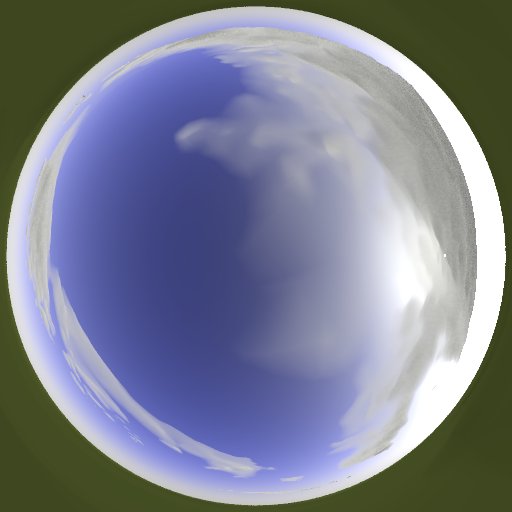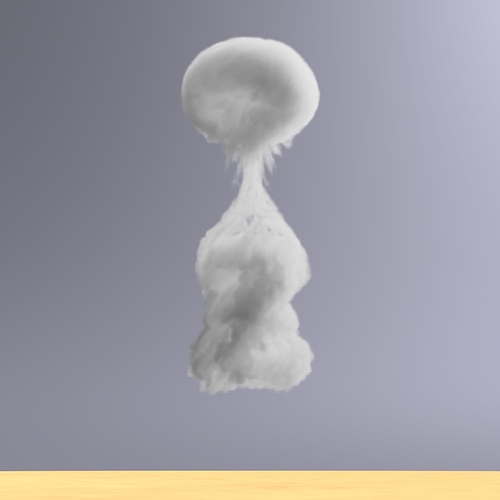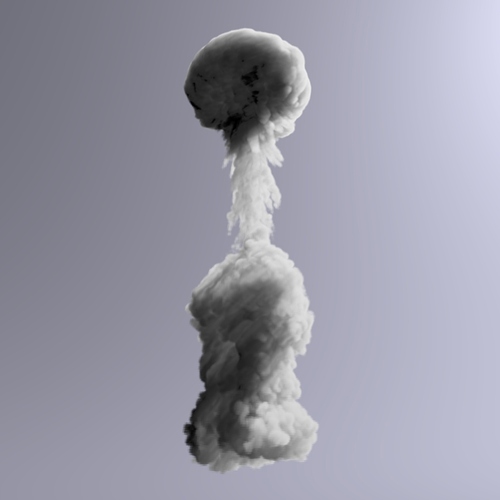Hi guys!
I am a student of a course about Radiance so I am quite new with the software. I looking for information an existing model of a cloud so I would like to analyses it and maybe i will try to improve it or to develop something similar.
I hope that someone could help me!
Best Regards
Eduardo Artigas
Eduardo,
I have done some experimentation with clouds in Radiance, and there
are two ways that seem to work.
One is to define a closed cloud volume and apply the "mist" material
to it. This mesh must be closed, watertight, and non-intersecting, and
will appear to be of constant "cloud" density. It helps considerably
if it's in the shape of a cloud. It can look something like this:
The other method allows varying density throughout the cloud, but is a
lot more work. It consists of creating a large number of small,
non-overlapping cubes (a dense matrix of cubes with small spaces
between them), each with a different mist material applied to them.
These options seemed to create the most cloud-like volumes (with
clouds of size 1 and mist "voxels" of size ~0.01):
-ma 0.95 0.95 0.95 -mg 0.05 -ms 0.001
Mark
···
On 2/22/15, Eduardo Artigas <[email protected]> wrote:
Hi guys!
I am a student of a course about Radiance so I am quite new with the
software. I looking for information an existing model of a cloud so I would
like to analyses it and maybe i will try to improve it or to develop
something similar.
I hope that someone could help me!
Best Regards
Eduardo Artigas
Thanks for sharing, Mark. I'm always delighted to see someone figure out how to do something with Radiance that I have no idea how to do, myself!
Cheers,
-Greg
···
From: Mark Stock <[email protected]>
Subject: Re: [Radiance-general] Modeling a cloud
Date: February 23, 2015 11:36:28 AM PSTEduardo,
I have done some experimentation with clouds in Radiance, and there
are two ways that seem to work.One is to define a closed cloud volume and apply the "mist" material
to it. This mesh must be closed, watertight, and non-intersecting, and
will appear to be of constant "cloud" density. It helps considerably
if it's in the shape of a cloud. It can look something like this:
http://markjstock.org/graphics/ray/clouds04.jpgThe other method allows varying density throughout the cloud, but is a
lot more work. It consists of creating a large number of small,
non-overlapping cubes (a dense matrix of cubes with small spaces
between them), each with a different mist material applied to them.
http://markjstock.org/transfer/img2_00.jpg
http://markjstock.org/transfer/img3_01.jpgThese options seemed to create the most cloud-like volumes (with
clouds of size 1 and mist "voxels" of size ~0.01):
-ma 0.95 0.95 0.95 -mg 0.05 -ms 0.001Mark
On 2/22/15, Eduardo Artigas <[email protected]> wrote:
Hi guys!
I am a student of a course about Radiance so I am quite new with the
software. I looking for information an existing model of a cloud so I would
like to analyses it and maybe i will try to improve it or to develop
something similar.
I hope that someone could help me!
Best Regards
Eduardo Artigas
Those clouds are awesome!!
Not sure if useful for you (probably not)... But, why not using HDR probes
of real skies? And maybe, with your models, find a way of creating and/or
writing artificial probes?
Bye!
···
El feb 23, 2015 4:47 PM, "Greg Ward" <[email protected]> escribió:
Thanks for sharing, Mark. I'm always delighted to see someone figure out
how to do something with Radiance that I have no idea how to do, myself!Cheers,
-Greg> From: Mark Stock <[email protected]>
> Subject: Re: [Radiance-general] Modeling a cloud
> Date: February 23, 2015 11:36:28 AM PST
>
> Eduardo,
>
> I have done some experimentation with clouds in Radiance, and there
> are two ways that seem to work.
>
> One is to define a closed cloud volume and apply the "mist" material
> to it. This mesh must be closed, watertight, and non-intersecting, and
> will appear to be of constant "cloud" density. It helps considerably
> if it's in the shape of a cloud. It can look something like this:
> http://markjstock.org/graphics/ray/clouds04.jpg
>
> The other method allows varying density throughout the cloud, but is a
> lot more work. It consists of creating a large number of small,
> non-overlapping cubes (a dense matrix of cubes with small spaces
> between them), each with a different mist material applied to them.
> http://markjstock.org/transfer/img2_00.jpg
> http://markjstock.org/transfer/img3_01.jpg
>
> These options seemed to create the most cloud-like volumes (with
> clouds of size 1 and mist "voxels" of size ~0.01):
> -ma 0.95 0.95 0.95 -mg 0.05 -ms 0.001
>
> Mark
>
>
> On 2/22/15, Eduardo Artigas <[email protected]> wrote:
>> Hi guys!
>> I am a student of a course about Radiance so I am quite new with the
>> software. I looking for information an existing model of a cloud so I
would
>> like to analyses it and maybe i will try to improve it or to develop
>> something similar.
>> I hope that someone could help me!
>> Best Regards
>> Eduardo Artigas_______________________________________________
Radiance-general mailing list
[email protected]
http://www.radiance-online.org/mailman/listinfo/radiance-general


